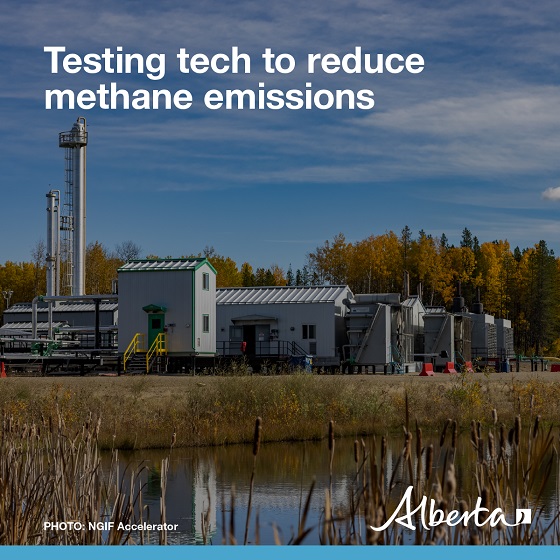Alberta
Alberta’s methane emissions fall 52 per cent

Alberta has cut its methane emissions from the oil and gas sector in half, showing how to reduce emissions and keep powering the world.
As global demand for energy continues to rise, Alberta remains one of the most responsible producers in the world. The province was the first in Canada to set a methane emissions reduction target for the upstream oil and gas sector, and its approach has won international awards and recognition.
This is the message Alberta’s government will take to COP 29. The Alberta approach is working. It is possible to reduce methane emissions and grow the economy, all while delivering the safe, affordable, reliable energy the world will need for generations to come.
According to the latest data from the Alberta Energy Regulator, Alberta has now officially reduced methane emissions from the oil and gas sector by 52 per cent since 2014, even as production has continued rising. The province’s common-sense approach is reducing emissions, creating jobs and growing the economy without punitive federal regulations or caps.
“We do not need Ottawa to tell us how to reduce emissions. In fact, the federal government should learn from Alberta’s success. By working closely with industry and focusing on technology, not costly taxes or unrealistic targets, we can achieve rapid emission reductions while delivering the safe, affordable, reliable energy the world needs.”
Under Alberta’s equivalency agreement with the Government of Canada, the province is in charge of regulating methane emissions. Alberta’s approach is working closely with industry and focusing on achievable results, including early action programs like carbon offsets, implementation of strong provincial regulatory requirements in place for all facilities, and improved leak detection and repair. This is estimated to have saved industry about $600 million compared with the alternative federal regulations that would otherwise have been required.
Since 2020, Alberta has invested $78 million from the industry-funded Technology Innovation and Emissions Reduction program to improve methane monitoring and management. Almost 15,000 well sites and facilities have been reviewed across the province, preventing nearly 17 million tonnes of emissions from being released.
Continuing this momentum, the province recently announced $15 million in funding for the NGIF Emissions Testing Centre to help companies test technologies free of charge in both laboratory and live settings, attract investors and get methane emissions reduction technologies to market faster. Alberta is also engaging with industry to develop a flexible, forward-looking path that will keep reducing emissions while supporting responsible energy production.
“Tourmaline, like other producers in Western Canada, has been diligently reducing methane emission intensity across our field operations, and we are targeting a 55 per cent reduction from 2020 levels by 2027. We operate a world-leading methane emissions testing centre (ETC) at our West Wolf Lake gas plant near Edson, Alberta. At the ETC site, the latest technologies to better measure and mitigate future methane emissions are being developed.”
Minister of Environment and Protected Areas Rebecca Schulz will travel to the 29th Conference of the Parties to the United Nations Framework Convention on Climate Change (COP 29) from Nov. 10 to 16 to share Alberta’s success with the world. Alberta’s environment minister will use the largest global climate summit to promote the province’s effective approach to reducing emissions while keeping energy reliable, secure and affordable.
Alberta’s government is committed to working with national and international partners to advance shared interests that can lead to new opportunities for people and businesses around the world.
Minister Schulz will attend COP29 with one staff member and three department officials. Mission expenses will be posted on the travel and expense disclosure page.
Itinerary for Minister Schulz*
| Nov. 10-11 |
|
| Nov. 12 |
|
| Nov. 13 |
|
| Nov. 14 |
|
| Nov. 15 |
|
| Nov. 16 |
|
*Subject to change.
Quick facts
- The Alberta Energy Regulator monitors, compiles and reports methane emissions data by facility type, production type and area. It releases the ST60B report annually to ensure the public and stakeholders have the latest information about methane emissions from Alberta’s upstream oil and gas sector.
- Alberta carbon offset protocols resulted in more than 58,000 low- or no-bleed devices being installed, and more than 7 million offset credits have been serialized.
- Alberta uses a combination of bottom-up and top-down measurement, monitoring and verification techniques as part of methane measurement compliance data.
Related information
Alberta
Alberta school boards required to meet new standards for school library materials with regard to sexual content

Alberta’s government has introduced new standards to ensure school library materials are age-appropriate.
School libraries should be safe and supportive places where students can learn and explore without being exposed to inappropriate sexual content. However, in the absence of a consistent standard for selecting age-appropriate library materials, school boards have taken different approaches, leading to concerns about safeguards in place.
In response to these concerns, and informed by feedback from education partners and the public, Alberta’s government has created standards to provide school boards with clear direction on the selection, availability and access to school library materials, such as books.
“Our actions to ensure that materials in school libraries don’t expose children to sexual content were never about banning books. These new standards are to ensure that school boards have clear guidance to ensure age-appropriate access to school library materials, while reflecting the values and priorities of Albertans.”
The new standards set clear expectations for school library materials with regard to sexual content and require school boards to implement policies to support these standards.
Standards for school library materials
Under the new standards, school libraries are not permitted to include library materials containing explicit sexual content. Non-explicit sexual content may be accessible to students in Grade 10 and above, provided it is age-appropriate.
“Protecting kids from explicit content is common sense. LGBTQ youth, like all children, deserve to see themselves in stories that are age-appropriate, supportive and affirming – not in material that sexualizes or confuses them.”
School boards must also regularly review their school library collections, publish a full list of available materials and ensure that a staff member supervises students’ access to school library materials. School boards will have to remove any materials with explicit sexual content from their school libraries by October 1.
School board policies and procedures
All school boards must have publicly available policies that align with the new standards for selecting and managing library materials by January 1, 2026. School boards can either create new policies or update existing ones to meet these requirements.
These policies must outline how school library materials are selected and reviewed, how staff supervise students’ access throughout the school day, and how a student, parent, school board employee or other member of the school community can request a review or removal of materials in the school library. School boards are also required to clearly communicate these policies to employees, students and parents before January 2026.
“A robust, grade- and age-appropriate library catalogue is vital for student success. We welcome the ministry’s initiative to establish consistent standards and appreciate the ongoing consultation to help craft a plan that will serve our families and communities well.”
“Red Deer Public Schools welcomes the new provincial standards for school library materials. Our division is committed to maintaining welcoming, respectful learning spaces where students can grow and thrive. Under the new standards for school libraries, we remain dedicated to providing learning resources that reflect our values and support student success.”
Quick facts
- The new standards will apply to public, separate, francophone, charter and independent schools.
- The ministerial order does not apply to municipal libraries located within schools or materials selected for use by teachers as learning and teaching resources.
- From May 26 to June 6, almost 80,000 people completed an online survey to provide feedback on the creation of consistent standards to ensure the age-appropriateness of materials available to students in school libraries.
Related information
- Ministerial Order
- School library standards engagement
- Reference Materials: Content warning: this document contains graphic content that may be disturbing to viewers and is not appropriate for young viewers. Viewer discretion is advised.
Alberta
Fourteen regional advisory councils will shape health care planning and delivery in Alberta

Regional health councils give Albertans a voice
Albertans want a health care system that reflects where they live and adapts to the unique needs of their communities. As part of the province’s health care refocus, Alberta’s government committed to strengthening community voices by providing more opportunities for Albertans to bring forward their local priorities and offer input on how to improve the system.
The regional advisory councils, made up of 150 members from 71 communities, will advise Alberta’s four health ministries and the newly refocused health agencies: Primary Care Alberta, Acute Care Alberta, Assisted Living Alberta and Recovery Alberta. Each council will explore solutions to local challenges and identify opportunities for the health system to better support community decision-making.
“By hearing first-hand community feedback directly, we can build a system that is more responsive, more inclusive and ultimately more effective for everyone. I am looking forward to hearing the councils’ insights, perspectives and solutions to improve health care in all corners of our province.”
“Regional advisory councils will strengthen acute care by giving communities a direct voice. Their insights will help us address local needs, improve patient outcomes and ensure timely access to hospital services.”
“A ‘one-size-fits-all’ approach does not address unique regional needs when it comes to mental health and addiction challenges. These councils will help us hear directly from communities, allowing us to tailor supports and services to meet the needs of Albertans where they are.”
“Every community has unique needs, especially when it comes to seniors and vulnerable populations. These regional advisory councils will help us better understand those needs and ensure that assisted living services are shaped by the people who rely on them.”
Members include Albertans from all walks of life, health care workers, community leaders, Indigenous and municipal representatives, and others with a strong tie to their region. About one-third of members work in health care, and more than half of the council chairs are health professionals. Almost one-quarter are elected municipal officials, including 10 serving as chairs or vice-chairs. Ten councils also include a representative from a local health foundation.
Council members will share local and regional perspectives on health care services, planning and priorities to help ensure decisions reflect the realities of their communities. By engaging with residents, providers and organizations, they will gather feedback, identify challenges and bring forward ideas that may not otherwise reach government.
Through collaboration and community-informed solutions, members will help make the health system more responsive, accessible and better able to meet the needs of Albertans across the province.
“As Primary Care Alberta works to improve access to primary health care services and programs across Alberta, we are grateful to have the opportunity to tap into a dedicated group of community leaders and representatives. These people know their communities and local needs, and we look forward to learning from their experiences and knowledge as we shape the future of primary care in Alberta.”
“The regional advisory councils will help to bring forward the voices of patients, families and front-line providers from every corner of Alberta. Their insights will help us plan smarter and deliver care that’s timely, effective and truly local. We look forward to working closely with them to strengthen hospital and surgical services across the province.”
“Nobody understands the health care challenges unique to a community better than the people who live there. The regional health advisory councils are made up of those living and working on the front lines across the province, ensuring we are getting the perspective of Albertans most affected by our health care system.”
“Alongside Recovery Alberta’s staff and physician team, these regional advisory councils will build upon the high standard of mental health, addiction and correctional health services delivered in Alberta.”
Indigenous Advisory Council
Alberta’s government continues to work directly with Indigenous leaders across the province to establish the Indigenous Advisory Council to strengthen health care services for First Nation, Métis and Inuit communities.
With up to 22 members, including Indigenous health care workers, community leaders and individuals receiving health care services, the council will represent diverse perspectives across Alberta. Members will provide community perspectives about clinical service planning, capital projects, workforce development and cultural integration in health care.
Related information
-

 Bruce Dowbiggin2 days ago
Bruce Dowbiggin2 days agoThe Covid 19 Disaster: When Do We Get The Apologies?
-

 Crime1 day ago
Crime1 day agoSweeping Boston Indictment Points to Vast Chinese Narco-Smuggling and Illegal Alien Labor Plot via Mexican Border
-

 Alberta1 day ago
Alberta1 day agoAlberta school boards required to meet new standards for school library materials with regard to sexual content
-

 Environment1 day ago
Environment1 day agoEPA releases report on chemtrails, climate manipulation
-

 Business15 hours ago
Business15 hours agoTrump slaps Brazil with tariffs over social media censorship
-

 International15 hours ago
International15 hours agoSupport for the Ukraine war continues because no one elected is actually in charge.
-

 Addictions17 hours ago
Addictions17 hours agoCan addiction be predicted—and prevented?
-

 Business18 hours ago
Business18 hours agoCBC six-figure salaries soar



